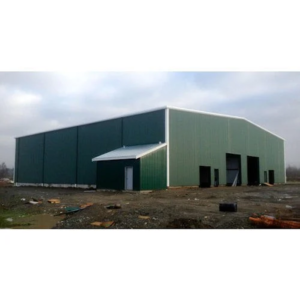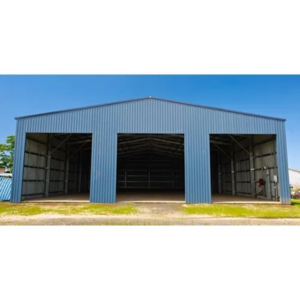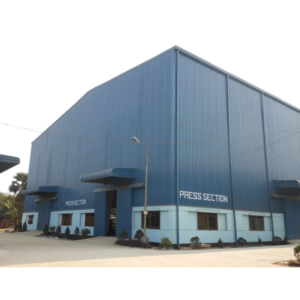Pre Engineered Steel Building
Pre-Engineered Steel Buildings: A Comprehensive Guide
Introduction to Pre-Engineered Steel Buildings
Pre-engineered steel buildings (PEBs) are custom-designed, factory-manufactured structures that are fabricated and assembled to fit specific customer needs. These buildings are made primarily of steel components and offer a robust, durable, and versatile solution for both industrial and commercial applications. The concept of pre-engineered steel buildings has revolutionized construction by providing a faster, more cost-effective, and highly efficient way to build various types of buildings, ranging from warehouses, factories, and storage facilities to sports complexes, retail outlets, and even residential homes.
PEBs are engineered and manufactured using advanced computer-aided designs (CAD), ensuring that every component of the building is precisely fabricated to match the client’s requirements. The manufacturing process involves the creation of various steel components, such as the framework, roof panels, wall panels, columns, and other structural elements. Once these components are ready, they are transported to the construction site and assembled according to the pre-designed plans.
The use of steel as the primary material in pre-engineered buildings provides several advantages, including superior strength, resistance to the elements, fire resistance, and sustainability. Moreover, because these buildings are pre-fabricated and assembled off-site, the construction timeline is significantly reduced, resulting in quicker project completion and faster returns on investment.
In this detailed guide, we will delve into all aspects of pre-engineered steel buildings, including their benefits, components, applications, construction process, and maintenance. Whether you’re considering a PEB for a business or a personal project, this guide will provide you with all the necessary information to understand why pre-engineered steel buildings are an excellent choice for modern construction needs.
What is a Pre-Engineered Steel Building?
A Pre-Engineered Steel Building (PEB) is a structure that is designed and fabricated in a factory, typically made from high-quality steel. These buildings are engineered to meet specific requirements for structural integrity, performance, and durability, with the key components of the building designed and manufactured in advance. These components are then transported to the construction site for assembly, drastically reducing construction time compared to traditional building methods.
The primary structure of a pre-engineered steel building consists of:
-
Structural Steel Frame: This includes columns, rafters, and purlins that make up the skeleton of the building.
-
Roof and Wall Panels: Made of steel or other materials, these panels provide the building’s weatherproofing and insulation properties.
-
Foundation and Flooring: The foundation is engineered to support the structure and may include concrete, piers, or other foundations depending on the building’s requirements.
-
Doors and Windows: Pre-designed door and window units are also included, based on the needs of the building.
-
Insulation and Accessories: Insulation systems are often integrated into the building’s design, especially for climates that demand temperature control.
These buildings can be designed to serve multiple purposes, including storage, manufacturing, agricultural uses, and even residential living.
Benefits of Pre-Engineered Steel Buildings
Pre-engineered steel buildings offer several benefits that make them the preferred choice for many businesses and individuals. Below are some of the key advantages:
1. Speed of Construction
The most significant advantage of pre-engineered steel buildings is the speed at which they can be constructed. Since most of the components are pre-fabricated in the factory, the assembly process on-site is much quicker than traditional construction methods. The components are ready for assembly upon delivery, reducing on-site construction time, and enabling faster project completion. This is especially beneficial in commercial construction, where time is often a critical factor.
2. Cost-Effectiveness
Pre-engineered steel buildings are often more affordable than traditional construction options. The efficiency of manufacturing and assembling components, combined with the lower labor costs, makes PEBs a cost-effective solution. Additionally, these buildings require fewer materials, reducing waste and lowering overall construction costs. The reduced need for skilled labor and the faster construction timeline also contribute to cost savings.
3. Durability and Strength
Steel is known for its strength and durability, making it ideal for use in pre-engineered buildings. Steel is resistant to common issues that affect traditional buildings, such as termites, rot, and mold. Moreover, steel structures are highly resistant to extreme weather conditions like heavy winds, rain, and even earthquakes, making PEBs particularly suitable for locations prone to such events.
4. Customization
Despite being pre-engineered, these buildings are highly customizable. The design can be tailored to meet the specific requirements of the client. Whether it’s the size, shape, layout, or additional features such as insulation, windows, doors, or mezzanines, PEBs can be modified to suit the purpose they will serve. The use of advanced software and CAD tools ensures that each design is optimized for performance and aesthetics.
5. Energy Efficiency
Energy-efficient features can be incorporated into the design of a pre-engineered steel building. This includes insulated roof and wall panels, which help regulate the interior temperature and reduce energy consumption. Energy-efficient lighting, HVAC systems, and the use of sustainable materials can further enhance the building’s energy efficiency. These features help to reduce long-term operating costs and support sustainable building practices.
6. Low Maintenance
Steel structures require very little maintenance over their lifespan. Unlike wood or other materials that may rot or need frequent repairs, steel buildings are resistant to corrosion and wear, provided they are properly maintained. The factory-applied coatings on steel components are designed to protect against environmental damage, which significantly reduces the frequency of repairs.
7. Sustainability
Pre-engineered steel buildings are environmentally friendly because steel is 100% recyclable. At the end of its useful life, a steel building can be dismantled, and its components can be reused or recycled. This reduces the environmental impact of construction and contributes to sustainable building practices. Additionally, the energy-efficient design of PEBs further promotes sustainability by reducing energy consumption.
8. Safety and Fire Resistance
Steel is a non-combustible material, which gives pre-engineered steel buildings an inherent advantage in fire safety. The fire-resistant properties of steel help ensure the safety of the building and its occupants. In addition, the design of the building allows for easier evacuation routes in case of emergencies, further enhancing safety.
Components of Pre-Engineered Steel Buildings
The design and structure of a pre-engineered steel building are carefully planned to ensure that it is safe, durable, and functional. The key components that make up a pre-engineered steel building include:
1. Steel Frames
The steel frame forms the foundation of the building. It typically consists of vertical columns and horizontal beams that support the weight of the roof and walls. The steel frame is designed for maximum strength while being lightweight, making it easy to assemble.
2. Roof and Wall Panels
The roof and wall panels of a pre-engineered steel building are typically made from steel, aluminum, or composite materials. These panels are available in a range of colors and finishes to suit the aesthetic preferences of the client. Insulated panels may also be used to improve energy efficiency.
3. Insulation
Insulation plays a crucial role in maintaining the temperature inside a pre-engineered steel building. Insulation can be installed in the walls, roof, and floor to improve thermal performance. This is especially important for buildings used for commercial, industrial, or residential purposes where temperature control is required.
4. Foundation
The foundation of a pre-engineered steel building is carefully designed based on the size, weight, and location of the building. It may consist of concrete pads, piers, or a full concrete slab, depending on the structural needs of the building.
5. Doors and Windows
Pre-engineered steel buildings come with a variety of door and window options to meet the needs of the building’s function. These may include roll-up doors, sliding doors, or traditional hinged doors, as well as windows for natural light and ventilation.
6. Accessories
Additional components such as gutters, downspouts, skylights, and ventilation systems can be integrated into the design of a pre-engineered steel building to enhance its functionality and aesthetic appeal.
Applications of Pre-Engineered Steel Buildings
Pre-engineered steel buildings are versatile and can be used for a wide range of applications. Below are some of the most common uses:
1. Industrial and Commercial Buildings
PEBs are widely used in the industrial and commercial sectors for constructing warehouses, factories, distribution centers, retail stores, and more. The customizable design allows for the creation of large open spaces without the need for internal columns or supports, making them ideal for manufacturing or storage.
2. Agricultural Buildings
Steel buildings are frequently used in the agricultural industry for constructing barns, storage sheds, animal shelters, and greenhouses. The durability and strength of steel are perfect for buildings that need to withstand harsh environmental conditions.
3. Sports and Recreation Facilities
Pre-engineered steel buildings are commonly used for sports complexes, gyms, and recreational centers. The open-span design allows for large, unobstructed interior spaces, making them ideal for sports courts, swimming pools, or gymnasiums.
4. Residential Buildings
While less common, pre-engineered steel buildings are increasingly being used in the residential sector for building homes. These homes are durable, energy-efficient, and require less maintenance than traditional homes. Some people also use PEBs for constructing garages, workshops, or guesthouses.
5. Educational Institutions
Schools, colleges, and universities often use pre-engineered steel buildings for classrooms, auditoriums, and laboratories. The speed of construction and durability of steel make it an excellent choice for educational institutions.
6. Retail and Commercial Complexes
PEBs are also used in the construction of retail spaces, shopping centers, and commercial complexes. The flexibility of design allows these buildings to be adapted for various uses, from storefronts to office spaces.
Construction Process of Pre-Engineered Steel Buildings
The construction of a pre-engineered steel building involves several stages, each of which is carefully planned and executed to ensure the final structure is safe, functional, and durable. The construction process typically includes the following steps:
1. Design and Engineering
The first step is the design phase, where architects and engineers work together to develop a custom plan for the building. This includes determining the size, layout, and materials used for the building, as well as addressing any local building codes or regulations.
2. Fabrication
Once the design is finalized, the components of the building are fabricated in the factory. This includes cutting, shaping, and welding the steel components, such as the columns, rafters, and roof panels. The components are carefully manufactured to meet the specific requirements of the design.
3. Delivery and Assembly
Once the components are fabricated, they are delivered to the construction site. The assembly process involves the erection of the steel frame, installation of the roof and wall panels, and connection of all components. The construction team works quickly to assemble the building, often completing the structure within weeks.
4. Finishing Touches
After the main structure is in place, the final touches are added, including insulation, doors, windows, and any other features specified in the design. The building is then inspected to ensure it meets all safety standards and client requirements.
Maintenance and Care for Pre-Engineered Steel Buildings
Pre-engineered steel buildings are low-maintenance structures, but regular inspections and minor maintenance can ensure their longevity. Here are some key maintenance tips:
1. Routine Inspections
Inspect the building regularly for any signs of wear and tear, such as cracks in the panels or rust on the steel frame. Early detection of problems can prevent costly repairs in the future.
2. Cleaning
Keep the exterior of the building clean by washing it regularly to remove dirt, debris, and pollutants that can accumulate over time. Cleaning the building’s roof and gutters is particularly important to prevent water damage.
3. Repairing Damage
If any part of the building is damaged, whether due to external factors or normal wear and tear, it should be repaired promptly. Small cracks or rust spots should be addressed before they cause larger structural issues.
4. Repainting
Steel components may need to be repainted over time to protect them from corrosion. Repainting the structure can help maintain its appearance and protect it from the elements.
Conclusion
Pre-engineered steel buildings offer an array of benefits, including durability, cost-effectiveness, speed of construction, and versatility. These buildings are ideal for a wide range of applications, from industrial and commercial use to residential and agricultural purposes. With advanced design capabilities, these buildings can be customized to suit the needs of any project. By understanding the components, benefits, and applications of PEBs, you can make an informed decision about using this innovative construction solution for your next building project. Whether you need a warehouse, a retail store, or a sports facility, pre-engineered steel buildings provide an efficient and long-lasting solution to meet your needs.




